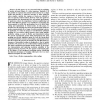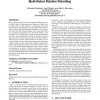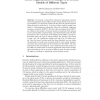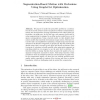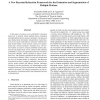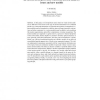284
Voted
EMMCVPR
2011
Springer
14 years 5 days ago
2011
Springer
Abstract. We present two data-driven importance distributions for particle filterbased articulated tracking; one based on background subtraction, another on depth information. In ...
105
Voted
TCSV
2010
14 years 7 months ago
2010
In this paper, we are concerned with the modeling of motion between frames of a video sequence. Typically, it is not possible to represent the motion between frames by a single mod...
99
Voted
ICIP
2010
IEEE
14 years 10 months ago
2010
IEEE
A block based video coder that supports multiple motion models is proposed. Apart from the typical translational motion model, we employ parametric models to more accurately repre...
113
click to vote
CGF
2007
15 years 13 days ago
2007
In this paper, we propose an online motion capture marker labeling approach for multiple interacting articulated targets. Given hundreds of unlabeled motion capture markers from m...
121
Voted
CVIU
2006
15 years 14 days ago
2006
We explore an approach to 3D people tracking with learned motion models and deterministic optimization. The tracking problem is formulated as the minimization of a differentiable ...
121
Voted
ATAL
2008
Springer
15 years 2 months ago
2008
Springer
There is growing interest in multi-robot frequency-based patrolling, in which a team of robots optimizes its frequency of point visits, for every point in a target work area. In p...
102
click to vote
ECCV
2006
Springer
15 years 4 months ago
2006
Springer
We propose a closed form solution for segmenting mixtures of 2-D translational and 2-D affine motion models directly from the image intensities. Our approach exploits the fact that...
115
click to vote
DAGM
2006
Springer
15 years 4 months ago
2006
Springer
Abstract. We propose to tackle the optical flow problem by a combination of two recent advances in the computation of dense correspondences, namely the incorporation of image segme...
119
Voted
SSIAI
2000
IEEE
15 years 4 months ago
2000
IEEE
In this paper we propose a new probabilistic relaxation framework to perform robust multiple motion estimation and segmentation from a sequence of images. Our approach uses displa...
101
Voted
SCVMA
2004
Springer
15 years 5 months ago
2004
Springer
Abstract. In this paper, several important issues related to visual motion analysis are addressed with a focus on the type of motion information to be estimated and the way context...

